Book contents
- Frontmatter
- Contents
- Figures
- Tables
- Contributors
- 1 Introduction: corporate governance after the ‘end of history’
- Part I Historical trajectories of business and regulation
- Part II New interests, new shareholder constellations, new landscapes
- 8 Beyond the Berle and Means paradigm
- 9 Pension funds as owners and as financial intermediaries
- 10 Credit derivatives market design
- 11 The EU Takeovers Directive: a shareholder or stakeholder model?
- 12 “Law and finance”
- Part III Labor’s evolution in the new economy
- Part IV The transnational embedded firm and the financial crisis
- Part V Conclusion
- Index
- References
9 - Pension funds as owners and as financial intermediaries
a review of recent Canadian experience
from Part II - New interests, new shareholder constellations, new landscapes
Published online by Cambridge University Press: 07 September 2011
- Frontmatter
- Contents
- Figures
- Tables
- Contributors
- 1 Introduction: corporate governance after the ‘end of history’
- Part I Historical trajectories of business and regulation
- Part II New interests, new shareholder constellations, new landscapes
- 8 Beyond the Berle and Means paradigm
- 9 Pension funds as owners and as financial intermediaries
- 10 Credit derivatives market design
- 11 The EU Takeovers Directive: a shareholder or stakeholder model?
- 12 “Law and finance”
- Part III Labor’s evolution in the new economy
- Part IV The transnational embedded firm and the financial crisis
- Part V Conclusion
- Index
- References
Summary
Acting like owners?
In the spring of 2007, a venerable Canadian corporation, Bell Canada Enterprises (BCE), became an acquisition target, and an acquisition agreement was subsequently signed. Until the deal was unwound on a technical valuation clause, it was the biggest proposed leveraged buyout in Canadian history: it was big news. Some of the features of this transaction were the size and nature of the target (formerly a regulated monopoly) and the identity of the primary purchaser, Ontario Teachers’ Pension Plan (OTPP, an occupational pension plan for elementary and secondary school teachers). It might not have attracted much more attention – pension funds had been purchasing and controlling companies in Canada for a decade or more – but then in August 2007, about two months after the deal was made, the Canadian and then global credit markets seized up, and the General Financial Crisis (GFC), as it has come to be known, ensued. About a year later, the deal was unwound, but only after the bondholders of BCE visited the Supreme Court of Canada complaining of their treatment through the whole process.
Forgotten now are some of the more curious local aspects of this deal: OTPP (or any other pension fund) was prohibited from owning BCE – at least on paper – by Ontario pension legislation. The CEO of OTPP, a public sector union pension plan, publicly mused that it may restructure BCE, which implied tackling the unionized BCE employees. Indeed, it was said anecdotally that OTPP had a policy of not investing in businesses that sponsored defined benefit pension schemes – of which OTPP was one of the biggest in Canada. Contrary to past practice, in this deal, a major Canadian pension fund sought to own a local business, instead of purchasing, say, privatized UK utilities, far from the concerns of local pensioners.
- Type
- Chapter
- Information
- The Embedded FirmCorporate Governance, Labor, and Finance Capitalism, pp. 177 - 204Publisher: Cambridge University PressPrint publication year: 2011
References
- 3
- Cited by



